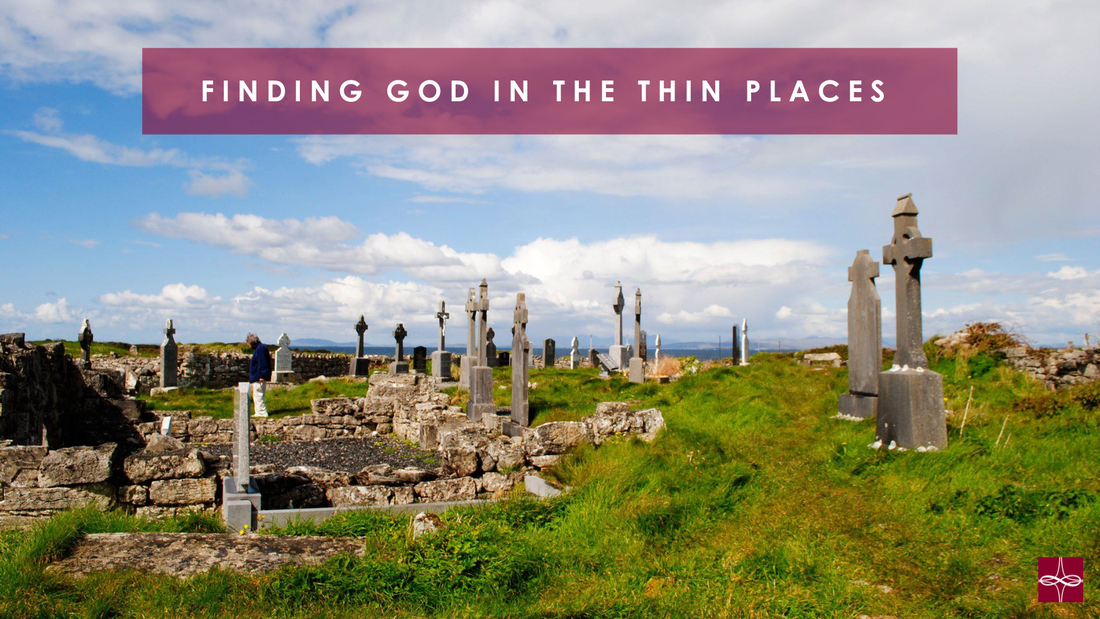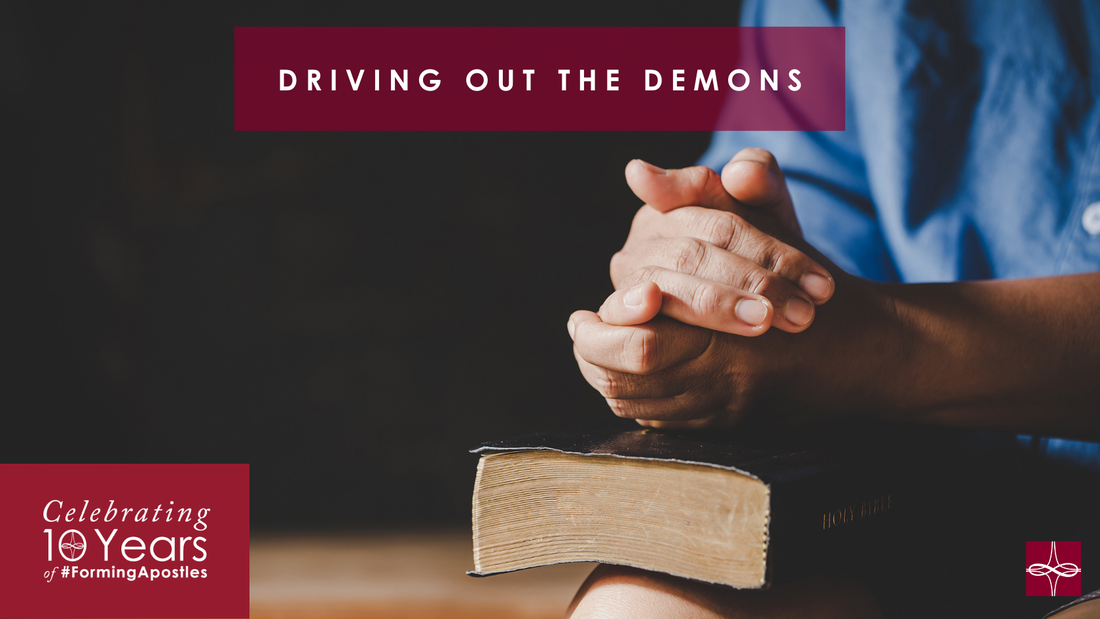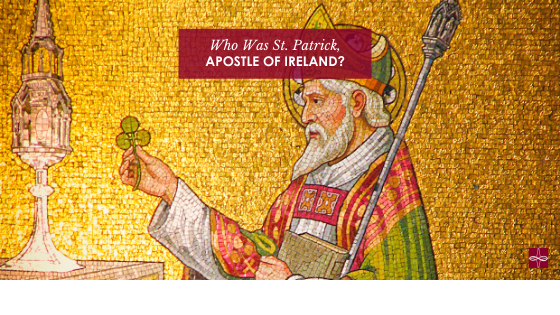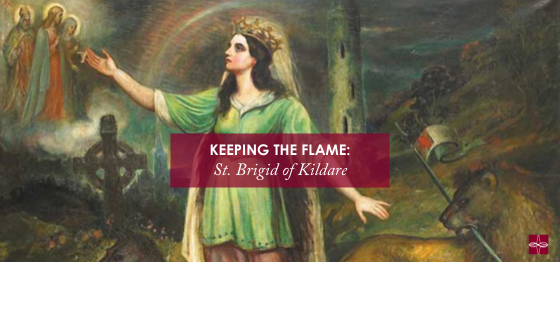|
In college I was lucky enough to spend a semester in Cork, Ireland. In my Irish folklore class, my professor, a charming little Irish woman, introduced us to ‘tír na nÓg.’ Fundamental to Irish folklore, she described tír na nÓg as a liminal space, the betwixt and between. It is the thin veil that separates the supernatural world of the fairies from our natural, human one. In these places, there was much less of a divide between the supernatural and natural worlds. While Ireland is well known for its Celtic spirituality and folklore, it also has a strong Catholic tradition. As Catholicism took root in the country, the ancient traditions and rituals were maintained and incorporated into the Christian spirituality. In her book, Braving the Thin Places, Irish Catholic author Julianne Stanz draws out this connection. Just as tír na nÓg is the place where the mystical is believed to be closer at hand, we also have these “threshold places” in our own spiritual lives. Instead of thinking about the supernatural in terms of fairies, we can consider the way that God descends into our world and the places where we have a deeper sense of His mystical presence and action. Our personal thin places are those where “God is felt and near” (Stanz, 2021, p. xvii). But as most people who have desired to develop a deeper relationship with God will know, it can take time to become attuned to this nearness and let Him break through. For some, this breaking through can be spurred by beauty. In seeing a striking rainbow over the Irish countryside or beholding a newborn child, we can have an overwhelming sense of God’s power and work in our midst. In other cases, this breaking through may be the result of a personal difficulty or interior struggle. As Christ himself revealed, “For human beings this is impossible, but for God all things are possible” (Matthew 19:26). It is when our own powers fail, whether in comprehending the immensity of God’s goodness or in overcoming the difficulties we encounter, that we approach the threshold where God, with His strength and love, awaits us. Throughout the Old Testament, God revealed his nearness to his people: “What other nation is so great as to have their gods near them the way the Lord our God is near us whenever we pray to him?” (Deuteronomy 4:7) God approached the threshold of our lives and invited us to draw near to Him in return. In the Incarnation of Jesus, this nearness is made even more real to us. If tír na nÓg is the veil that separates the supernatural from the natural, Jesus fully pulls back this curtain. By descending into our world, He made space for the divine within the human. We call this grace; divine life within us. Grace works in our threshold places and enables us to discern God’s work and act upon His promptings. In concluding her book, Stanz speaks of the mysticism we must have, “an abandonment to the adventure of living with ‘holy worldliness’ as we try to experience in the thin places the wild things of God” (p. 169). Far from recklessness, this abandonment is a surrender to God and a trust in the ways He is working in our lives. It is “the free response of the human person to the initiative of God who reveals himself” (Catechism of the Catholic Church § 166). If we know God is near and for us, how can we not cross this threshold and rely on Him? The beloved Irish saint, St. Patrick, in his famous lorica or breastplate prayer models this reliance on God and belief in God’s nearness and power to cross the threshold of his humanity: I arise today Through God's strength to pilot me; God's might to uphold me, God's wisdom to guide me, God's eye to look before me, God's ear to hear me, God's word to speak for me, God's hand to guard me, God's way to lie before me, God's shield to protect me, God's hosts to save me. May we all have the grace to enter into our threshold places and be open to the powerful work of God in each of our lives! Stanz, J. (2021). Braving the Thin Places. Loyola Press. **Photo from Erin Donn.**
0 Comments
Ever since creation, mankind has had to battle against evil. In every age, Satan has been prowling about seeking to destroy, attempting to separate us from our life in Christ. Fortunately, because God cares for us so immensely, He has given us countless tools to equip us in this battle. Romans 8 reminds us: “What will separate us from the love of Christ? Will anguish, or distress, or persecution, or famine, or nakedness, or peril, or the sword?... For I am convinced that neither death, nor life, nor angels, nor principalities, nor present things, nor future things, nor powers, nor height, nor depth, nor any other creature will be able to separate us from the love of God in Christ Jesus our Lord.” However, because our loving God created us in freedom, it is a daily act of the will to remain in His love and under His umbrella of protection. We have resources to help in the fight against evil, as well as advocates we can call upon to accompany us in driving away the demons that seek our ruin. One such advocate whom we celebrate today is St. Patrick. A simple young man who was sold into slavery to Ireland in the 5th century, St. Patrick ultimately gained his freedom and chose to return to the land of his captivity as a missionary to spread the love and truth of God. While in captivity, Patrick prayed constantly and nurtured his faith to overcome the harsh circumstances, and God strengthened him to grow into a saintly superhero known for driving out demons. His prayer, the Lorica (otherwise known as St. Patrick’s Breastplate), is comprehensive in covering all the ways we can be attacked by evil. It is a beautiful prayer that my husband and I pray aloud together each morning; and I can attest to its protection in many incidences. The act of reciting this prayer brings a spiritual covering over us when prayed in faith. St. Patrick is celebrated annually on March 17th, a feast day which occurs during the season of Lent. Today, we can attend Mass on this day and enjoy a traditional Irish meal and festivities as we remember the gift Patrick gave us by his example of driving out evil and spreading God’s love amidst treacherous conditions. He is a bigger than life example for me of how God can equip us with His power to do battle against evil. And Lent is a perfect time in the Church year to remember and celebrate him. During the season of Lent, we focus on our individual weaknesses that allow evil to creep into our lives and practice ways to defeat the darkness within and around us. We look inward and examine our thoughts, words, and actions through prayer, fasting, and almsgiving. These three Lenten pillars can be physical ways to drive out evil influences, reorient our hearts and minds to serve others, and recommit to living in Christ. Having such a superhero of faith as Patrick helps me realize that I need help and cannot do it on my own. Cardinal John Henry Neumann reminds us: “We are not our own masters. Through creation, redemption and regeneration we are God’s property and He has a triple claim upon us. We find that independence was not made for us – it’s an unnatural state, and will not carry us on safely to the end. We are creatures and have two duties – to be resigned and to be thankful.” So, I contemplate during this season of Lent that I am in need of a Savior! Each day I need to rededicate myself to more time in self-examination and prayer for divine assistance to battle against the evil in my life. The Church offers us ways to walk with our brothers and sisters through the Stations of the Cross, to redirect us to follow in Christ’s footsteps. There’s great power in doing this together, as most battles are won by an army working together. Other suggestions for becoming more adept in driving away the demons and battling evil are:
Lastly, I encourage you to adjust your armor daily as instructed in Ephesians 6:11, 14-18: “Put on the full armour of God so as to be able to resist the devil’s tactics. So, stand your ground, with truth a belt around your waist, and uprightness a breastplate, wearing for shoes on your feet the eagerness to spread the gospel of peace and always carrying the shield of faith so that you can use it to quench the burning arrows of the Evil One. And then you must take salvation as your helmet and the sword of the Spirit, that is, the word of God. In all your prayer and entreaty keep praying in the Spirit on every possible occasion. Never get tired of staying awake to pray for all God’s holy people.” Through Christ and the intercession of the saints, particularly St. Patrick, I can wholeheartedly enter into these weeks of Lent to learn more precisely how to drive out the evil in my own life so I can be more disposed to proclaim the love of Christ in who I am and what I do. May you have a Lent filled with freedom from all evil and experience a deep renewal in living for Christ! For more Lenten resources, please click here. To learn more about St. Patrick, please click here. Founded in the 17th Century, Saint Patrick’s Day is both a commemoration of Ireland’s patron saint as well as a popular celebration of Irish culture enjoyed worldwide by the Irish and the Irish-at-heart. Folks wear green, host parties and parades, and enjoy Irish food, drink, and dancing. While the holiday holds special significance for Irish-Americans (who represent the largest chunk of the global Irish diaspora), Saint Patrick’s Day is a feast that all are invited to share in. The lasting, inclusive nature of this holiday has much to do with the Irish people, their fight for freedom, and their collective experience as immigrants in America. Fittingly, Ireland’s patron saint was himself an immigrant to Ireland from his native Roman-British shores. We celebrate Patrick today because he successfully spread Christianity across 5th century Ireland – a mission that forever altered the destiny of the Irish people. Patrick is beloved for preaching in the Gaelic language, for using natural imagery to illustrate Gospel truths, and for driving away superstitious pagan beliefs. Like many early saints, Patrick’s story is a mixture of legend and fact. However, beyond the colorful lore stands a real person whose deeds and words continue to inspire and affect us. To help you better know the man behind the myth, here are ten fascinating facts about Ireland’s very first bishop: 1. Patrick was not born Irish. While he spent the majority of his life living among and ministering to the Irish people, Patrick was a Roman Briton by birth. His exact birthdate and birthplace are uncertain, but it is believed he was born in Scotland, England, or in northern Wales around 386 A.D. 2. Patrick first came to Ireland as the captive of Irish pirates. Patrick was a teenager when he and “a large number of his father’s slaves” were stolen and sold into slavery by Irish raiders. This began a six-year stay of captivity in Ireland, during which Patrick’s spiritual conversion began while he labored as a shepherd. 3. Patrick escaped slavery with help from a dream. After years of suffering and intense prayer, a voice in his dream said, “You have fasted well. Very soon you will return to your native country” [Confessio, 17]. The voice then told him where he would find a ship, some two hundred miles away, to carry him home to Britain and his family. 4. Patrick spent time studying for the priesthood in France. After his return to the Britons, Patrick travelled and continued his studies in Christianity at Auxere, France (formerly Gaul), possibly visiting Marmoutier Abbey in Tours, before being ordained. 5. Patrick received a vision calling him back to Ireland. After his parents begged him to cease his adventures, Patrick received another dream in which a man approached him carrying letters from the Irish people and imploring his return. Fr. Jack Wintz, OFM says, “What is interesting about this dream… is that it came not as a directive from God, but as a plea from the Irish…. Patrick wasn't commanded to bring civilization or salvation to the heathens. He was invited to live among them as Christ's witness.” 6. Patrick’s Irish mission was unpopular. Few of Patrick’s brother clergy shared his sympathy for the Irish people, who were viewed as barbaric and hostile. Patrick’s superiors disapproved of his calling; his Confessio (first-person account of his life) was written partially as a defense and a response to critics of his mission. 7. Patrick wasn’t the first Christian missionary to Ireland. Fr. Jack explains, “There were some Irish Christians, mostly on the eastern and southeastern coast. Many of these were probably British slaves who had been taken into captivity by the Irish. There is a record of a Bishop Palladius being sent to Ireland before Patrick. But the mission of Patrick was unique.” 8. Patrick taught the Gospel through Celtic language and symbolism. Patrick preached effectively in the Gaelic tongue, and he employed pre-existing pagan symbols in transmitting the faith. While Patrick’s use of the three-leaf clover to illustrate the Trinity was likely a later addition to his legend, Patrick’s Confessio specifically details his distinctions between Irish pagan sun worship and Christian worship – including Old Latin wordplay of the words sun and Son. Irish priest Fr. Liam Lawton notes, “the Celtic cross we know today was basically a cross superimposed on the sun… Patrick convert[ed] sun worship to Son worship.” 9. Patrick drove out superstitious practices, rather than snakes. Patrick is said to have driven out “all the snakes of Ireland” into the sea. While the National Museum of Ireland’s fossil collections and records provide no evidence for snake species ever having existed in Ireland, Patrick likely did the Irish a greater service through his concrete and traceable efforts to build churches and ordain Irish priests—efforts which helped to drive out the druids who had formerly dominated Irish spiritual affairs. 10. Patrick wasn’t always associated with the color green. Jumping forward in time – Saint Patrick’s Day celebrations first bloomed in America in the early 1700s, where the Irish diaspora developed them into the holiday we recognize today. However, says NYU professor Marion Casey, “It wasn’t until 1798, the year of the Irish Rebellion, that the color green became officially associated with the day.” Before then, “The color associated with St. Patrick was blue, as it was featured both in the royal court and on ancient Irish flags. But as the British wore red, the Irish chose to wear green, and they sang the song ‘The Wearing of the Green’ during the rebellion, cementing the color’s relevance in Irish history.” Wishing you a blessed and fun Saint Patrick’s Day – Sláinte (Health)! The lives of the Irish saints have been a wonderful inspiration in my life and faith journey. As I am a descendant of Irish immigrants to America, the hagiographies of saints like Patrick, Columba, and Brigid contain threads of Celtic culture and history that help me to understand Ireland better. These stories also help me as I seek God in daily life and in my relationships with others. Just a few days ago, the Church celebrated the Feast of St. Brigid of Kildare. Along with St. Patrick and St. Columba, St. Brigid is considered a patron saint of Ireland. Born in the 5th century, much of her life is detailed only in myth and legend. However, in later biographies, it is agreed that Brigid was born around 450 A.D. to a Christian woman and slave named Broicsech, who herself was baptized by St. Patrick. Brigid was a generous girl who performed deeds of charity at an early age. She was “veiled,” or accepted into religious life, and later became abbess. From this point on, the miracles attributed to Brigid are fantastic and too numerous to list here. The most well-known story may be that of Brigid’s cloak. According to legend, Brigid once approached the King of Leinster requesting land on which to build her monastery. When the miserly king refused, Brigid asked, “Give me as much land as my cloak will cover.” Laughing at the small cloak in her arms, the king agreed. Yet Brigid asked four of her helpers to pull the cloak in opposite directions. As the helpers ran north, south, east and west, the cloak grew and grew until it covered many acres, and the king pleaded with her to stop. He agreed to donate adequate land, on which was built Brigid’s famous monastery at Kildare. The king later converted to Christianity. For many years—pre-dating Christianity—a sacred fire that was kept by local priestesses had been burning in Kildare. Brigid continued this custom of keeping a fire alight (now representing the new light of Christianity) as she established what is considered the first monastery for women in Ireland. Incredibly, Brigid’s fire burned continuously into the 16th century! Brigid also founded a monastery for men around the same time. As a prototype for women of leadership in the faith, “Brigid held a unique position in the Irish Church and in the society of her day. As Abbess, she presided over the local Church of Kildare and was leader of a double monastery for men and women” (The Brigidine Sisters). Brigid died on February 1st, 525 A.D., which we celebrate now as her feast day. Brigid’s Day is associated with many customs in Ireland and throughout the world, including candle-lit pilgrimages and the weaving of Brigid’s Crosses (instructions on how to make your own Brigid’s Cross here). Brigid’s feast day aligns with Imbolc, the ancient pagan festival marking the beginnings of the return of spring – another example of her legacy bridging the gap between the old world and the new. Brigid is remembered today as a woman of contemplation and action, devoted to serving others and bringing an end to strife and conflict. She is also held as a model for creative co-operation with God, and is a favored saint of many artists, musicians, and writers. Brigid lived and died nearly 1500 years ago, yet I am confident that the example of her life has never been more relevant. Just like Brigid’s time, this century we live in calls for dynamic conflict resolution skills and creative community-building efforts. Like Brigid, we too must protect and care for the vulnerable among us. And for a Church seeking better ways to engage and accompany young people regarding discernment and faith, the model of a young woman and entrepreneurial leader like Brigid offers clear insight for how to engage and empower the next generation. This weekend is the feast of St. Patrick—one of the most popular saints in the Archdiocese of Washington where I grew up and arguably in the entire United States. But two days later on March 19, coming much more quietly and with far less fanfare in American culture, slips in the Solemnity of St. Joseph.
It is easy to lose the Solemnity of St. Joseph in the rigors of Lenten observances or because it comes on the heels of the day-long party that seems to happen every year on St. Patrick’s Day. Perhaps we often overlook this feast because we know so little about who St. Joseph was and what his life was like. Nevertheless, St. Joseph remains an incredibly important figure, especially for parents. Joseph is mentioned only a few times in the New Testament. We know from the Gospels that Joseph was a law-abiding and righteous man, and that he obeyed God’s will—especially when it was revealed to him directly by an angel. After these few mentions in the infancy narratives of Jesus, St. Joseph gently fades into the background and then disappears altogether from the Gospels. But the Church in her wisdom has made St. Joseph’s importance clear for those who are paying attention: he is mentioned in all four Eucharistic Prayers at Mass, as well as in the Divine Praises during Benediction at the end of Eucharistic adoration. But what makes St. Joseph so special? From what we can glean from the Gospels, St. Joseph was an ordinary man of deep faith who was called to become the foster-father of Christ. He became the earthly guardian of the Messiah, responsible for his upbringing and tasked with protecting him in his early life. St. Joseph’s commitment to his vocation as the husband of Mary and the foster father of Christ was so strong that upon being warned about the murderous intentions of King Herod, he fled immediately—in the middle of the night!—to Egypt. He did whatever it took, even leaving his entire life behind him, in order to keep his family safe. The little we see of him in the New Testament shows us a devout man who always trusted in God and took care of his family. St. Joseph, as the third member of the Holy Family, is the member who is the most like us—especially those of us who are parents. He was not born sinless, nor was he divine. He was a carpenter, a man of humble station who probably felt as though he had a monumentally important task thrust upon him. I think St. Joseph’s role in Christ’s life beautifully displays the role of a Christian parent in their child’s life. Parents are ordinary people who are tasked with the care and raising of new life. Like Joseph, we do not own our children or have sole claim over them; they are their own people, entrusted to our care and guidance until they grow old enough to do God’s will without our assistance. It is a difficult task, and at times overwhelming to ponder. And yet there is St. Joseph, who was tasked with raising the very Son of God. Joseph shows us that we do not need to be perfect in our roles, only willing to be guided by God as we place our trust in Him. Just as I strive to be like Mary in my vocation as a wife and mother, I pray that my husband will be like Joseph. St. Joseph is the ultimate husband and father, a faithful man of quiet strength, protector of Mary’s virginity, and guide of Christ’s earthly childhood. Above all, St. Joseph shows us the beauty of a life lived in obedience to God’s will. Questions for Reflection: How can you grow closer to St. Joseph throughout this Lenten season? What can you learn from St. Joseph’s example of obedience and trust? |
Details
Archives
July 2024
Categories
All
|
About |
Media |
© COPYRIGHT 2024 | ALL RIGHTS RESERVED










 RSS Feed
RSS Feed